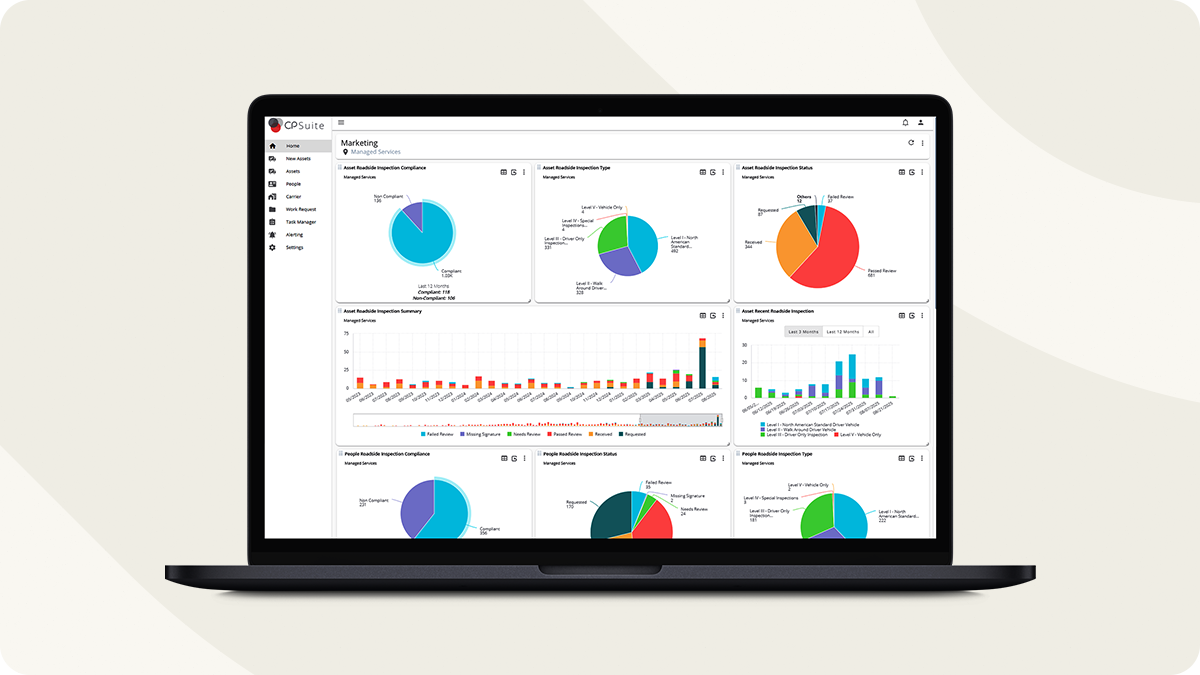Every mile driven comes with inherent risks, from unpredictable road conditions and distracted motorists to mechanical failures and driver fatigue. For companies that rely on commercial vehicles to power their business, the consequences of a single crash can be severe—ranging from injuries and lawsuits to equipment damage, downtime, and a tarnished reputation.
According to the FMCSA, large trucks were involved in over 168,000 injury crashes and 5,000 fatal crashes in a recent year. Beyond the tragic human toll, these incidents cost fleets millions in legal expenses, insurance premiums, operational disruptions, and brand damage. The reality is clear: prioritizing truck driver safety is essential not only for protecting lives but also for ensuring the long-term success of your fleet operation.
But safety isn’t achieved through compliance alone. It requires a proactive, layered approach that integrates the right people, processes, and technologies. From rigorous driver screening and training to real-time behavior monitoring and preventive maintenance, the most successful fleets adopt a comprehensive safety culture that empowers drivers and management alike.
The Foundations of Truck Driver Safety
Establishing a safe fleet begins with strong foundations. These are the core principles and systems that uphold every safety initiative, from high-level policies to day-to-day driver behavior. Two of the most critical pillars are regulatory compliance and a safety-focused fleet culture. When these are properly built and reinforced, they create the environment needed to support long-term, sustainable safety improvements.
A. Regulatory Compliance
FMCSA/DOT Safety Regulations
At the heart of truck driver safety are the federal regulations enforced by the Federal Motor Carrier Safety Administration (FMCSA) and the Department of Transportation (DOT). These rules are designed to reduce crashes, injuries, and fatalities involving commercial motor vehicles. Key requirements include:
- Hours of Service (HOS) rules to prevent driver fatigue
- Electronic Logging Devices (ELDs) to ensure accurate tracking of driving hours
- Vehicle inspection, repair, and maintenance standards
- Drug and alcohol testing programs
- Driver Qualification File (DQF) requirements
Noncompliance can result in fines, out-of-service orders, and downgraded safety ratings, all of which affect a fleet’s bottom line and reputation.
CSA Scores and Their Impact
The Compliance, Safety, Accountability (CSA) program is the FMCSA’s primary tool for identifying high-risk motor carriers. Scores are generated in seven BASICs (Behavior Analysis and Safety Improvement Categories), including Unsafe Driving, Hours-of-Service Compliance, and Driver Fitness.
Poor CSA scores can:
- Trigger DOT audits or investigations
- Lead to higher insurance premiums
- Discourage shippers and brokers from working with your fleet
- Impact driver recruiting and retention
Maintaining strong CSA scores is not just a compliance measure—it’s a business-critical performance metric that reflects your fleet’s overall safety and reliability.
Importance of Maintaining Driver Qualification Files (DQFs)
A well-maintained Driver Qualification File (DQF) is more than a regulatory requirement—it’s your fleet’s first line of defense in proving a driver’s eligibility, safety readiness, and compliance. Every commercial driver must have a complete, up-to-date DQF that includes:
- Motor Vehicle Records (MVRs)
- Medical examiner certificates
- Proof of CDL and endorsements
- Road test results or equivalent certifications
- Previous employer verifications
Failure to maintain DQFs can result in significant fines and may leave a fleet exposed during litigation following an accident. Automation tools and digital DQF management systems can greatly reduce risk and streamline compliance.
B. Safety-Focused Fleet Culture
Leadership Commitment to Safety
Safety begins at the top. Fleet executives and managers must set the tone by making safety a non-negotiable business value, not just a line item or compliance obligation. When leadership consistently demonstrates that driver well-being and public safety come before delivery deadlines, it sends a powerful message across the organization.
Examples of leadership involvement include:
- Regular participation in safety meetings
- Investing in safety training and technology
- Recognizing and rewarding safe driver behavior
- Making safety a key performance indicator for all departments
Building Accountability and Trust
Creating a culture of safety requires balancing accountability with support. Drivers need to know they are expected to follow protocols—but also that they’ll be treated fairly and supported in doing so. Transparency around safety metrics, clear expectations, and consistent enforcement are essential.
At the same time, fleets must avoid a “gotcha” mentality that punishes drivers for every mistake. Instead, focus on coaching, continuous improvement, and recognizing progress, especially when using telematics or camera systems.
Encouraging Open Reporting of Near Misses and Unsafe Conditions
A proactive safety culture encourages drivers and staff to report near misses, hazards, and unsafe behavior without fear of retaliation. These early warnings are goldmines for identifying and mitigating risks before they lead to serious incidents.
To foster reporting:
- Create anonymous or easy-to-use reporting channels
- Train supervisors to respond constructively to concerns
- Celebrate examples where reporting prevented incidents
- Integrate findings into ongoing training and policy updates
Hiring and Onboarding Best Practices
Hiring the right drivers and setting them up for success from day one are two of the most critical steps in building a safe and compliant fleet. A strong hiring and onboarding process acts as both a filter for risk and a foundation for safety culture, helping ensure that only qualified, safety-conscious individuals represent your company behind the wheel.
A. Rigorous Driver Screening
Before a driver gets into a company vehicle, you need a thorough vetting process that goes beyond basic qualifications. A rigorous screening process helps protect your fleet from hiring individuals who pose a risk to safety, compliance, and your reputation.
Background Checks (MVRs, PSP Reports)
Motor Vehicle Records (MVRs) and Pre-Employment Screening Program (PSP) reports provide critical insights into a driver’s history. These tools help you assess patterns of unsafe behavior, recent violations, and crash involvement. Best practices include:
- Reviewing 3-5 years of MVR data from all states where the driver held a license
- Using PSP reports to check DOT reportable crashes and inspections
- Setting clear internal standards for violations that trigger disqualification (e.g., DUI, reckless driving, excessive speeding)
Drug & Alcohol Testing
FMCSA regulations require pre-employment DOT drug testing for all CDL drivers. However, safety-driven fleets often go further by:
- Participating in the FMCSA Drug & Alcohol Clearinghouse
- Conducting hair follicle testing in addition to urinalysis to detect longer-term drug use
- Establishing zero-tolerance policies for substance abuse
- Ensuring policies align with DOT standards and state/local laws
Skills Assessments
Even experienced drivers can fall short of your fleet’s safety expectations. Hands-on skills assessments help evaluate:
- Backing, turning, and space management
- Pre-trip inspections
- Use of mirrors and blind spot awareness
- Ability to operate specific vehicle types or equipment (e.g., flatbeds, tankers, liftgates)
Combining road tests with written safety assessments ensures drivers not only meet minimum standards, but also align with your safety expectations and operational complexity.
B. Comprehensive Onboarding Process
Once a driver is hired, the onboarding process becomes your first opportunity to embed safety into their daily mindset. A structured, consistent onboarding experience equips drivers with the knowledge and tools needed to operate safely from day one.
Safety Training from Day One
New hires should receive targeted safety instruction covering:
- Defensive driving principles
- Accident reporting procedures
- Fatigue management and Hours of Service (HOS) compliance
- Use of in-cab safety systems (e.g., lane assist, dashcams)
- Company policies on mobile phone use, seat belts, and speed limits
Blending classroom instruction with hands-on demonstrations helps ensure knowledge retention and real-world application.
Orientation on Company-Specific Safety Protocols
Every fleet has its own expectations, risk profile, and operating environment. Your onboarding should clearly communicate:
- Expectations for vehicle inspections, incident reporting, and load securement
- Penalties for policy violations (e.g., unsafe driving, falsified logs)
- Internal safety scorecard metrics and how performance is measured
- Expectations around interaction with customers and the public
Clarity from the beginning helps avoid misunderstandings and builds mutual accountability.
Introduction to Equipment and Technology Tools
Modern fleets rely on a range of technologies to support safety, compliance, and efficiency. Onboarding should include detailed training on:
- Electronic Logging Devices (ELDs)
- Dash cameras (forward-facing and driver-facing)
- GPS and route management systems
- Collision avoidance and braking assistance systems (ADAS)
- Driver-facing mobile apps for pre-trip inspections or communication
Providing hands-on, real-time walkthroughs reduces driver frustration and helps maximize the value of your tech investments.
When hiring and onboarding are handled with safety at the core, you not only reduce risk—you establish a professional standard that resonates throughout your fleet’s operations.

Telematics and Driver Monitoring
Technology has transformed the way fleets manage driver safety. Through telematics systems and driver monitoring tools, fleets gain real-time visibility into how their vehicles are operated, allowing for faster intervention, better coaching, and stronger safety performance. When implemented thoughtfully, these tools empower drivers to improve while giving fleet managers actionable insights that drive accountability and continuous improvement.
A. Real-Time Behavior Monitoring
Real-time monitoring is the frontline defense against unsafe driving behavior. By leveraging in-vehicle sensors, GPS tracking, and integrated camera systems, fleets can identify and respond to risky actions as they happen, rather than after a crash occurs.
Dashcams (Forward-Facing and Driver-Facing)
Dash cameras have become standard equipment in safety-driven fleets. Their benefits include:
- Forward-facing dashcams record road events to provide context during collisions or near misses. They protect both the driver and the company by offering objective evidence in the event of a claim or lawsuit.
- Driver-facing dashcams (when used with clear policies and coaching intent) help monitor distraction, drowsiness, and seatbelt use. These tools are particularly effective in detecting behavioral issues before they lead to accidents.
Best practice: Use AI-enabled cameras to detect and flag behaviors in real time—such as eyes off the road, yawning, or using a phone—while preserving driver privacy through smart event-triggered recording.
Alerts for Unsafe Behaviors
Telematics platforms can issue instant alerts when high-risk behaviors are detected, including:
- Harsh braking or acceleration
- Sharp cornering or swerving
- Excessive speeding
- Tailgating
- Distracted or fatigued driving indicators
- Unauthorized route deviations or idling
These alerts can be configured to notify drivers immediately (in-cab coaching) or be sent to fleet managers for review, enabling timely corrective action and coaching before these behaviors escalate into incidents.
B. Scorecards and Feedback Loops
Data is only valuable if it leads to action. Driver scorecards and structured feedback loops turn raw telematics data into clear, fair, and actionable performance indicators that help drivers understand how they’re doing and what they can improve.
Transparent Driver Safety Scores
Telematics platforms typically aggregate data into individual safety scores based on specific behaviors. Key attributes of effective scorecards include:
- Clear metrics (e.g., speeding events per 100 miles, seatbelt compliance, distraction events)
- Rankings relative to peers (but used constructively, not punitively)
- Integration with company goals (e.g., score thresholds tied to incentives or disciplinary processes)
Transparency is critical—drivers should know exactly how their score is calculated, what behaviors impact it, and how to improve it.
Weekly/Monthly Performance Reviews
Regular coaching sessions turn scorecard data into meaningful conversations. These reviews should be:
- One-on-one, with a focus on individual goals
- Supportive, not punitive, using video footage or trend graphs as coaching tools
- Time-bound, tracking progress from week to week or month to month
- Paired with retraining or specific action plans for improvement
This creates a closed-loop system where drivers get regular feedback, can see their progress, and feel supported in their development.
Rewarding Safe Behavior
Positive reinforcement is one of the most effective tools in a fleet safety program. Safe driving incentive programs can include:
- Bonuses or gift cards for top safety performers
- Public recognition in newsletters, dashboards, or team meetings
- Tiered reward systems tied to long-term safety records
- Opportunities for career advancement or leadership roles
When drivers know their safe habits are being recognized—not just their mistakes—they become more engaged and invested in the fleet’s safety goals.
When used strategically, telematics and driver monitoring are not about surveillance—they’re about support, accountability, and shared responsibility for safety. These tools provide the data and insights needed to build a safer, more efficient fleet, and when paired with thoughtful coaching, they empower drivers to be their best behind the wheel.
Fatigue Management and Wellness
Fatigue is one of the most dangerous threats to truck driver safety—and one of the most difficult to detect in real time. Long hours behind the wheel, irregular schedules, inadequate rest, and poor health habits can all contribute to reduced alertness, slower reaction times, and poor decision-making. According to the FMCSA, driver fatigue is a contributing factor in thousands of truck-related crashes each year.
An effective fatigue management program combines compliance oversight, driver education, wellness initiatives, and scheduling practices to reduce risk and improve overall driver performance.
A. Hours of Service (HOS) Compliance
Using ELDs to Track and Manage Fatigue
The introduction of Electronic Logging Devices (ELDs) has greatly improved compliance with HOS regulations by automating the tracking of driving time, breaks, and rest periods. But ELDs are more than just compliance tools—they are valuable resources for managing fatigue proactively.
Best practices include:
- Monitoring ELD data not just for violations, but for fatigue risk indicators, such as long driving shifts near the maximum limit or missed rest opportunities.
- Integrating ELD data with telematics to predict fatigue trends, enabling dispatchers and safety managers to adjust routes or schedules accordingly.
- Using HOS data to balance productivity with safety, ensuring drivers have adequate time for rest and recovery between shifts.
Avoiding Violation-Triggered Fatigue Events
While ELDs help ensure compliance, fleets must go further to prevent fatigue-related incidents. This involves:
- Educating drivers on how to manage their energy levels throughout the day, including the dangers of “pushing through” when tired.
- Watching for patterns of repeated HOS violations, which may indicate poor planning, pressure from dispatchers, or unsafe habits.
- Empowering drivers to speak up when they’re fatigued, without fear of retaliation or lost income. A “safety-first” scheduling culture is essential.
B. Promoting Driver Health & Wellness
Healthy drivers are safer drivers. A robust wellness program goes beyond fatigue—it targets the physical and mental demands of life on the road and helps drivers develop sustainable habits that improve their alertness, focus, and job satisfaction.
Sleep, Diet, and Physical Fitness
Promoting good health begins with addressing three key pillars:
- Sleep: Provide education on sleep hygiene, including managing caffeine, using blackout curtains in sleeper cabs, and maintaining consistent sleep routines—even when off-duty.
- Diet: Encourage access to healthy food options, either through in-terminal offerings, meal planning guides, or partnerships with travel centers. Junk food and energy drinks might boost short-term energy but often lead to crashes in concentration.
- Physical activity: Share exercises drivers can do during breaks or while parked, such as stretching, walking, or bodyweight workouts. Some fleets even provide small exercise kits or promote walking challenges.
Offering health risk assessments and biometric screenings during annual physicals or driver appreciation events can also help catch problems early.
Mental Health Support Resources
Mental strain, stress, loneliness, and depression are often overlooked in the industry—but they have a real impact on driver behavior, focus, and decision-making.
Best practices for supporting mental wellness include:
- Providing access to Employee Assistance Programs (EAPs) that offer confidential counseling, stress management, and crisis support
- Training managers and dispatchers to recognize signs of mental distress and respond appropriately
- Reducing isolation by promoting peer networks, communication tools, or check-in calls that build camaraderie and connection
- Sharing mental health resources openly, without stigma, in newsletters, meetings, and training
Fatigue and poor health are safety risks you can’t afford to ignore. By combining data-driven fatigue monitoring with genuine wellness support, fleets can keep drivers sharper, healthier, and more engaged—while significantly reducing preventable incidents and long-term liability.




